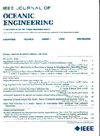A Ship Radiated Noise Recognition Method Applicable to Incomplete Training Data Sets
IF 5.3
2区 工程技术
Q1 ENGINEERING, CIVIL
引用次数: 0
Abstract
To effectively classify ship radiated noise signals under incomplete training data sets, this article proposes a ship radiated noise recognition method. This method consists of a feature selection method based on the Bhattacharyya distance measurement (FS-BD) and the fuzzy support vector machine (SVM) based on fuzzy support vector center (FSVM-fsv). In the feature extraction stage, FS-BD removes redundant dimensions based on the similarity of feature probability distribution, aiming to improve the separability of features. However, the complex underwater acoustic environment leads to heterogeneity between similar samples, which further causes the incompleteness of the learning feature set. In the classifier design, under the framework of SVM, the FSVM-fsv method uses the distance between samples and their respective fuzzy support vector centers to optimize the decision hyperplane's spatial division capability, thereby reducing the impact of outliers and noise on classifier performance. The experimental results show that the FS-BD method can significantly improve the difference and robustness of the target features under the condition of about 900 samples of single-class targets and containing multiple environments. At the same time, the performance of FSVM-fsv under incomplete training sets is better than other machine learning methods, such as SVM, FSVM based on class center, FSVM based on estimated hyperplane, FSVM based on actual hyperplane, and FSVM based on support vector center (FSVM-sv), and the average recognition accuracy reaches 84.65%. This recognition method provides a reliable solution for target recognition in unknown environments.一种适用于不完全训练数据集的船舶辐射噪声识别方法
为了对不完全训练数据集下的船舶辐射噪声信号进行有效分类,提出了一种船舶辐射噪声识别方法。该方法由基于Bhattacharyya距离测量(FS-BD)的特征选择方法和基于模糊支持向量中心(FSVM-fsv)的模糊支持向量机(SVM)组成。在特征提取阶段,FS-BD基于特征概率分布的相似性去除冗余维度,旨在提高特征的可分性。然而,复杂的水声环境导致相似样本之间存在异质性,这进一步导致了学习特征集的不完备性。在分类器设计中,在支持向量机的框架下,FSVM-fsv方法利用样本与各自模糊支持向量中心之间的距离来优化决策超平面的空间划分能力,从而降低异常点和噪声对分类器性能的影响。实验结果表明,在约900个单类目标样本和包含多个环境的情况下,FS-BD方法可以显著提高目标特征的差异性和鲁棒性。同时,FSVM-fsv在不完全训练集下的性能优于支持向量机、基于类中心的FSVM、基于估计超平面的FSVM、基于实际超平面的FSVM、基于支持向量中心的FSVM (FSVM-sv)等机器学习方法,平均识别准确率达到84.65%。该方法为未知环境下的目标识别提供了可靠的解决方案。
本文章由计算机程序翻译,如有差异,请以英文原文为准。
求助全文
约1分钟内获得全文
求助全文
来源期刊

IEEE Journal of Oceanic Engineering
工程技术-工程:大洋
CiteScore
9.60
自引率
12.20%
发文量
86
审稿时长
12 months
期刊介绍:
The IEEE Journal of Oceanic Engineering (ISSN 0364-9059) is the online-only quarterly publication of the IEEE Oceanic Engineering Society (IEEE OES). The scope of the Journal is the field of interest of the IEEE OES, which encompasses all aspects of science, engineering, and technology that address research, development, and operations pertaining to all bodies of water. This includes the creation of new capabilities and technologies from concept design through prototypes, testing, and operational systems to sense, explore, understand, develop, use, and responsibly manage natural resources.
 求助内容:
求助内容: 应助结果提醒方式:
应助结果提醒方式:


